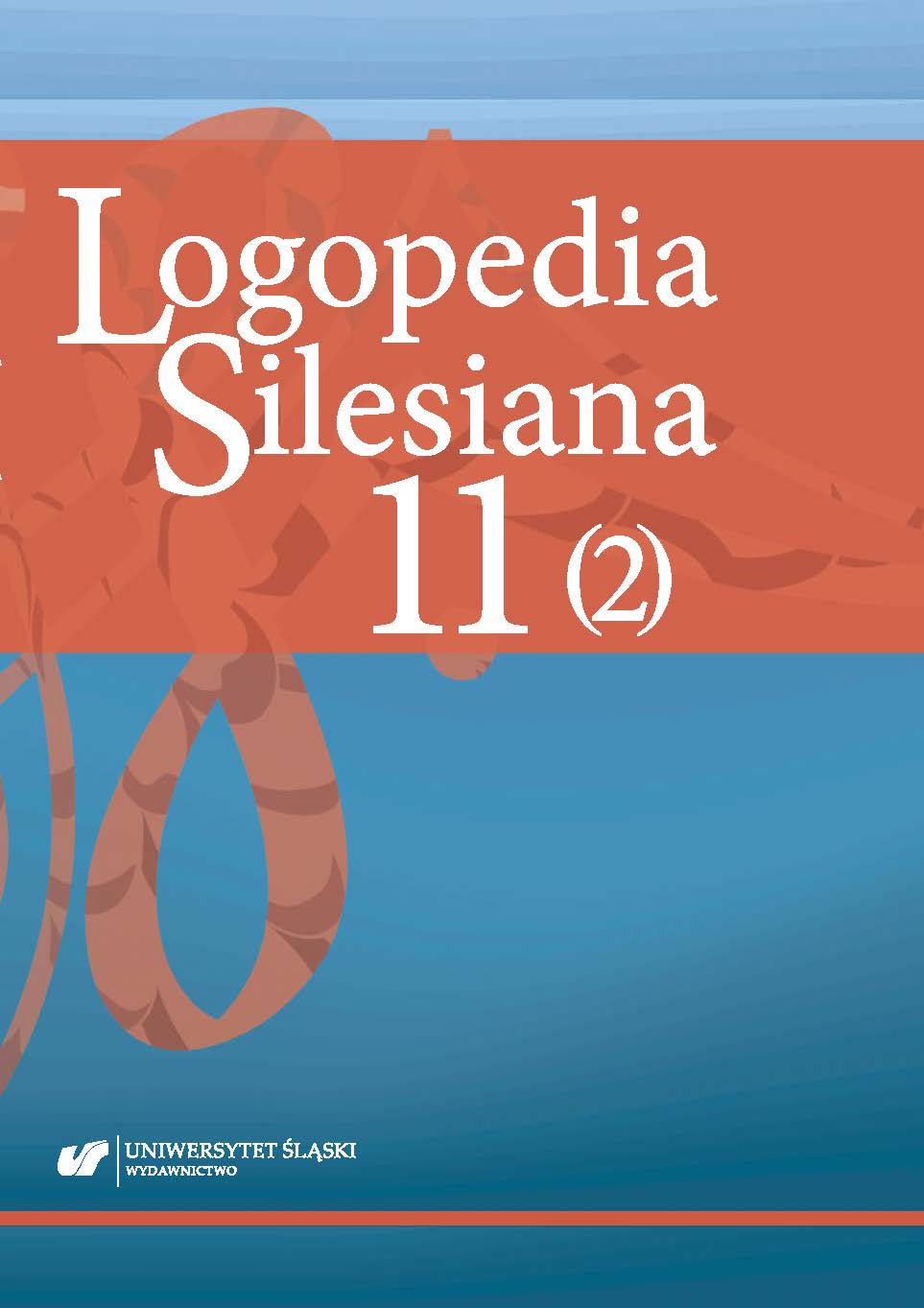Binkuńska, E. (2012). Higiena i emisja głosu mówionego. Wydawnictwo Uniwersytetu Kazimierza Wielkiego w Bydgoszczy.
Google Scholar
Ciecierska-Zajdel, B. (2012). Trening głosu. Praktyczny kurs dobrego mówienia. Samo Sedno.
Google Scholar
Forti, S., Amico, M., Zambarbieri, A., Ciabatta, A., Assi, C., Pignataro, L., Cantarella, G. (2014). Validation of the Italian voice handicap Index-10. Journal of Voice, 28(2), 263.e17–263.e22. https://doi.org/10.1016/j.jvoice.2013.07.013
Google Scholar
Gautam, R., Navak, S., Devadas, U. (2022). Perception of primary school teachers towards voice problems and vocal health-seeking behaviors: A qualitative study. Journal of Voice, 36(5), artykuł 022. https://doi.org/10.1016/j.jvoice.2022.03.022
Google Scholar
Giddens, Ch. L., Barron, K. W., Byrd-Craven, J., Clark, K. F., Winter, A. S. (2013). Vocal indices of stress. A review. Journal of Voice, 27(3), 390.e21–390.e29.
Google Scholar
Goldman, S. L., Hargrave, J., Hillman, R. E., Homlberg, E., Gress, C. (1996). Stress, anxiety, somatic complains and voice use in woman with vocal nodules. American Journal of Speech-Language Pathology, 5(1), 44–54. https://doi.org/10.1044/1058-0360.0501.44
Google Scholar
Gruszczyńska, M., Bąk-Sosnowska, M., Plinta, R. (2015). Zachowania zdrowotne jako istotny element aktywności życiowej człowieka. Stosunek Polaków do własnego zdrowia / Health-related behaviors as an essential part of human life activities. Attitude of Poles towards their own health. Hygeia Public Health, 50(4), 558–565.
Google Scholar
Guzy, A. (2019). Diagnoza emisji głosu z wykorzystaniem wywiadu ustrukturyzowanego – implikacje praktyczne. Logopaedica Lodziensia, 3, 79–91. https://doi.org/10.18778/2544-7238.03.06
Google Scholar
Guzy, A., Barańska-Grabara, L. (2012). Problemy głosowe nauczycieli. W: D. Umiastowska, J. Gebreselassie (red.), Zdrowie w perspektywie pedagogicznej (s. 145–159). Wydawnictwo Naukowe Państwowej Wyższej Szkoły Zawodowej.
Google Scholar
Haniszewska, K., Kaźmierczak, M. (2019). Higiena głosu artystów scenicznych. Doniesienie z badań. Logopedica Lodziensia, 3, 93–116 .
Google Scholar
Hashim, N. W., Wilkes M., Salomon, R., Meggs, J., France, D. J. (2017). Evaluation of voice acoustics as predictor of clinical depression scores. Journal of Voice, 31, 256.e1–256.e6.
Google Scholar
Havigerová, J. M., Dosedlová, J., Burešová, I. (2019). One health behavior or many health-related behaviors? Psychology Research and Behavior Management, 12, 23–30.
Google Scholar
Heszen, I., Sęk, H. (2008). Zdrowie i stres. W: D. Doliński, J. Strelau. Psychologia. Podręcznik akademicki (t. 2, s. 690–694). Gdańskie Wydawnictwo Psychologiczne.
Google Scholar
Heszen, I., Sęk, H. (red.). (2012). Psychologia zdrowia. Wydawnictwo Naukowe PWN.
Google Scholar
Houtte, E., Claeys, S., Wuyts, F. L., Van Lierde K. (2012). Voice disorders in teacher: Occupational risk factors and psycho-emotional factors. Logopedics, Phoniatrics, Vocology, 37(3), 107–116.
Google Scholar
Juczyński, Z. (2009). Narzędzia do pomiaru w promocji i psychologii zdrowia. Pracownia Testów Psychologicznych.
Google Scholar
Kisiel, M., (2012). Emisja i higiena głosu w pracy dydaktyczno-wychowawczej nauczyciela. Wydawnictwo Wyższej Szkoły Biznesu.
Google Scholar
Kropornicka, B., Baczewska, B., Dragan, W., Krzyżanowska, E., Olszak, C., Szymczuk, E. (2015). Zachowania zdrowotne studentów Uniwersytetu Medycznego w Lublinie w zależności od miejsca zamieszkania. Rozprawy Społeczne, 9(2), 58–64.
Google Scholar
Kubiak, S., Wiskirska-Woźnica, B., Demenko, G. (2006). Zarys higieny narządu głosu. Wydawnictwo Wyższej Szkoły Humanistyczno-Ekonomicznej.
Google Scholar
Leer, E., Hapner, E. R., Connor, P. N. (2007). Transtheoretical model of health behavior change applied to voice therapy. Journal of Voice, 22(6), 688–698, doi: https://doi.org/10.1016/j.jvoice.2007.01.011.
Google Scholar
Mateusiak, J., Gwozdecka-Wolniaszek, E. (2013). O zachowaniach zdrowotnych przez pryzmat współczesności. W: M. Górnik-Durose (red.), Kultura współczesna a zdrowie (s. 154–184). Gdańskie Wydawnictwo Psychologiczne.
Google Scholar
Mazurkiewicz, E. A. (1978). Podstawy wychowania zdrowotnego. W: Z. J. Brzeziński, C. W. Korczak (red.), Higiena i ochrona zdrowia. Państwowy Zakład Wydawnictw Lekarskich.
Google Scholar
Ostrowska, A. (1999). Styl życia a zdrowie. Z zagadnień promocji zdrowia. IFIS PAN.
Google Scholar
Pawłowski, R. (2008). Zachowania zdrowotne studentów I roku studiów a samoocena ich stylu życia. Zdrowie – Kultura Zdrowotna – Edukacja, 2, 117–123.
Google Scholar
Pawłowski, Z. (2010). Podstawy foniatrii dla osób duchownych, aktorów, nauczycieli i prawników. Wydawnictwo Salezjańskie.
Google Scholar
Prochaska, J. O., DiClemente, C. C. (1992). Stages of change in modification of problems behaviors. Progress in Behavior Modification, 28, 184–218.
Google Scholar
Puchalski, K. (1990). Zachowania związane ze zdrowiem jako przedmiot nauk socjologicznych. Uwagi wokół pojęcia. W: A. Gniazdowski (red.), Zachowania zdrowotne (s. 23–57). Wydawnictwo Instytutu Medycyny Pracy.
Google Scholar
Radosz, Z., Tomaszewska-Kumela, P., Paplaczyk, M., Gruszczyńska, M. (2020). Zachowania zdrowotne studentów kierunków medycznych / Medical students’ health behaviors. Rozprawy Społeczne / Social Dissertations, 14(2), 151–164. https://doi.org/10.29316/rs/122023
Google Scholar
Spantideas, N., Drosou, E., Karatsis, A., Assimakopoulos D. (2015). Voice disorders in the general Greek population and in patients with laryngopharyngeal reflux. Prevalence and risk factors. Journal of Voice, 29(3), 389.e27–389.e32.
Google Scholar
Ślusarska, B., Kulik, T. B., Piasecka, H., Pacian, A. (2012). Wiedza i zachowania zdrowotne studentów medycyny w zakresie czynników ryzyka sercowo-naczyniowego. Medycyna Ogólna i Nauki o Zdrowiu, 18(1), 19–26.
Google Scholar
Tarasiewicz, B. (2006). Mówię i śpiewam świadomie. Podręcznik do nauki emisji głosu. Universitas.
Google Scholar
Trinite, B., Sokolovs, J. (2014). Adaptation and validation of the voice handicap index in Latvian. Journal of Voice, 28(4), 452–457.
Google Scholar
Woynarowska, B. (2007). Edukacja zdrowotna. Wydawnictwo Naukowe PWN.
Google Scholar


 https://doi.org/10.31261/LOGOPEDIASILESIANA.2022.11.02.06
https://doi.org/10.31261/LOGOPEDIASILESIANA.2022.11.02.06

 10.31261/LOGOPEDIASILESIANA
10.31261/LOGOPEDIASILESIANA